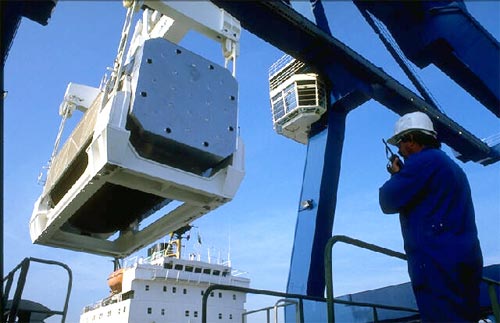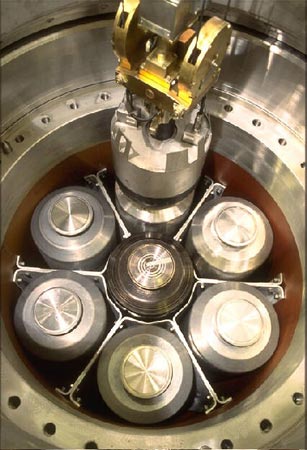Are radioactive material convoys dangerous?

Unloading a transport cask
Photo taken in the port of Cherbourg while unloading the Pacific Sandpiper, a special-purpose vessel designed to carry radioactive materials between Japan and France. In one direction, spent fuel packages from Japanese power plants are unloaded for processing in La Hague. Several years later, MOX fuel assemblies and vitrified waste from the reprocessing activity are shipped back to Japan. These marine transportation operations are rare and tightly controlled.
© SIDNEY JEZEQUEL /AREVA
The perceived dangers associated with transporting highly radioactive materials are a source of concern for the public. Anti-nuclear militants have on several occasions chained themselves to rail tracks to block convoys carrying irradiated nuclear fuel or vitrified waste to or from Germany. In 2004, a militant was unable to free himself as the train approached and tragically died.
What potential hazards does the transportation of radioactive material present? What precautions are taken? The vast majority (90%) of movements concern radioactive sources used in nuclear medicine at hospitals. These small-scale movements generally involve short distances and relatively low radioactivity levels. The corresponding precautions are those defined in the standard radiation protection guidelines.
The nuclear industry is responsible for the remaining 10% of movements, involving much larger consignments. The lowest-risk transport operations relate to the manufacture of fuel prior to loading into the reactor. Around 300 such movements are performed each year in France. Natural or enriched uranium is heavy but not highly radioactive. For example, the risks associated with the transport of uranium hexafluoride from the conversion plant to the enrichment plant are chemical rather than radiological.
Transport operations involving spent fuel unloaded from reactors are far more critical. Highly radioactive materials that are normally kept isolated from the living world must occasionally by moved by rail, road or sea. Such materials include spent fuel (450 movements), plutonium oxide powders and MOX fuel resulting from reprocessing operations. The highly radioactive packages are overpacked in solidly constructed, thick-walled “transport casks” designed to withstand impacts and fire, absorb intense gamma radiation emitted by their contents and dissipate heat released by radioactivity. Foreign vitrified waste produced at the reprocessing plant in La Hague must be returned to its country of origin. In particular, waste is sent by rail to Germany, and by sea to Japan. Such movements are rare and tightly controlled.
radiation emitted by their contents and dissipate heat released by radioactivity. Foreign vitrified waste produced at the reprocessing plant in La Hague must be returned to its country of origin. In particular, waste is sent by rail to Germany, and by sea to Japan. Such movements are rare and tightly controlled.

Vitrified waste transport cask
Vitrified waste other than waste coming from French power plants is returned to the owning power utility. This photo shows vitrified waste containers being loaded into a TN28V transport cask, which obeys a similar principle to those used to carry other highly radioactive materials such as irradiated fuel.
AREVA/Sydney Jezequel
After being reprocessed at the La Hague facility, vitrified waste and recoverable materials belonging to foreign companies are returned to their owners, in some cases by sea. In the United States, spent fuel is currently stored near the reactors. At some point in the future, this waste will be transported over long distances to the repository built instead of the abandoned Yucca Mountain project in Nevada.
In addition to the risk of accidental dissemination, the risks in terms of theft and terrorist activities must be addressed. These sensitive transport operations are subject to very stringent international regulations issued by the International Atomic Energy Agency (IAEA) as well as domestic regulations issued by safety authorities.
It is important to neither underestimate nor overestimate the danger. Spent fuel and waste transport movements concern extremely small volumes in comparison to those required for the oil supply chain, given that one gram of plutonium produces as much energy as a tonne of oil. MOX and plutonium shipments to Japan can be counted on the fingers of one hand, and pale in comparison to the veritable armada of tankers that move oil around the world. Sophisticated nuclear transport operations are strictly regulated and closely monitored. Nuclear transport operations have never caused a significant accident.
Other articles on the subject « Waste management »
Waste management status
Repositories already in operation for low-level waste Compared with other types of waste, the mas[...]
Other storage facilities
Interim waste storage according to their nature and origin Spent fuel and vitrified waste from Pr[...]
Temporary storage
A temporary solution Interim storage is a temporary solution that plays a central role in the man[...]
Vitrified waste Storage
Dry storage of vitrified waste Spent nuclear fuel assemblies are not the only materials removed f[...]
Spent fuel storage
Interim storage in pools and then dry locations In all countries, spent fuel management begins wi[...]
Management outside France
Overview of waste management strategies outside France Management of the least radioactive waste [...]
LILW-SL waste repository
Disposal of low and intermediate-level short-lived waste Low and intermediate-level short-lived w[...]
VLLW repository
An operational repository for very low-level waste The second category of waste for which a repos[...]
High level waste transportation
Moving highly radioactive materials The 10% of transport movements that concern high-level radioa[...]
Transport safety
Measures to ensure safe transport Nuclear materials may be highly radioactive. The goal is to pre[...]